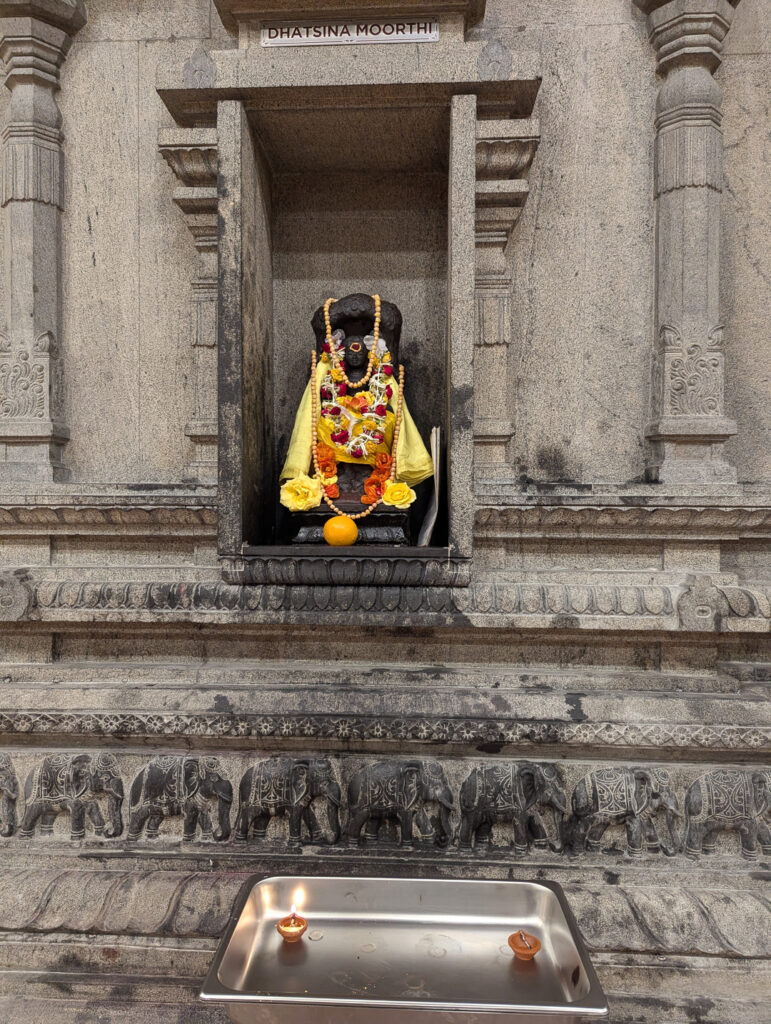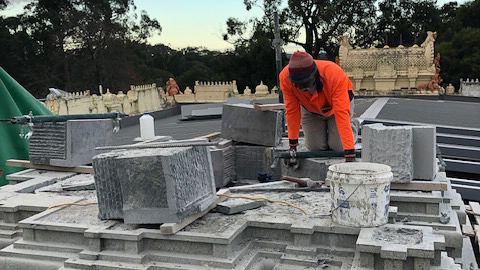The Sri Vakarathunda Vinayagar Temple in outer Melbourne is a monumental construction built on solid community foundations.
The bus dropped me at a dark bend in the Basin on the way to the Dandenong Ranges. It was a desolate spot, and I checked my rain-spattered Google Maps to see if I was at the right place. Eventually, past a tyre shop, I found my destination, the fabled Sri Vakrathunda Vinayagar Temple.
I wasn’t sure what to do at the entrance, so I rang my contact, Ramana, the secretary of the Temple. He was running 15 minutes late, but there would be someone to meet me. I saw the shoes left out in the rain and realised I had to take mine off and put up with damp socks. Incense wafted out, and I could see a busy scene within.
Kadiresan greeted me and immediately suggested I also take my hat off, “It blocks the energy.” Casting around the scene, I was overwhelmed by the number of deities. Kadiresan started explaining their various identities. He was particularly keen to tell me about Ardhanarishvara, which combines male and female identities. Lord Shiva loved his consort Parvati so intensely that he wanted to merge with her. He explained that this deity demonstrates the inseparability and interdependence of both male and female energies and the equality of men and women in the world. The result is a Hindu version of the Buddhist Taijitu that combines yin and yang. “They talk about gender equality today. This is from 5,000 BC.”, said Kadiresan
I noticed that the mouth of the granite face seemed darker than the rest of the body. Kadiresan said that this happens when worshippers touch the deity to pray: “The natural oil from their hands is absorbed by the granite stone with which the carving is made.” I saw apples as offerings for the deity as well. The temple seemed to be a very interactive space.
Sri Vakrathunda Vinayagar Temple is an epic project. A breakaway group from the Hindu Society of Victoria decided to construct Australia’s first temple dedicated to Vinayagar, the Tamil version of Ganesha, the elephant god. This was to be the first traditional Hindu Temple in Victoria. The core of the temple was the Moolasthaanam, a central shrine made of granite.
- Offering libations for the idols
- Water from washing the idol is collected for auspicious uses.
- Ghee is also lit as an offering to the deity
- Many deities are clothed
The project was overseen by Sthapati Mr Purushothaman, with help from the community. The first task was to find a quarry in southern India where a single source of granite could be extracted in order to avoid different shades and colours of granite on the same carving. Once the stones were identified, tests were completed to certify they were safe against earthquakes. The granite was then transported to Mamallapuram, near Chennai, where 60 traditional temple sculptors worked to cut and carve around 1,000 pieces. It was eventually transported to Melbourne along with 20 artisans, including eleven sculptors and eight stucco workers. They assembled the main shrine with 17 layers out of 400 stones. The largest, the shikhara (peak), weighed six tons. The result was a temple with the largest granite shrines in the Southern Hemisphere. This was entirely funded by devotees.
- Moolasthaanam, the central shrine in the temple
- Assembling granite pieces for the temple
- Artisans from Indian assembling the Moolasthaanam
- Carving granite in Mamallapuram
- Placing the shikhara on top of the shrine
When the temple was initially constructed back in 1992, the Ganesha statue was presented to the temple by the late Shankara Charya of the Kanchi Mutt, in Kanchipuram. Once the statue was given to the temple, there were important rituals to perform. The statues were kept at the Sri Senpaga Vinayagar temple in Singapore, where an “eye-opening” ceremony was performed to bring the deities to life. I remember my own visit to Mamallapuram when I was told that this involved putting a mirror up to a deity, so the first vision of the world is its own beauty.
My contact, Ramana, eventually arrived and suggested we go to their cafe for a meal. I took off my socks and began the barefoot experience, walking across the wet pavement. In the cafe, I’m served a south Indian dosa and idli—the best I’ve ever tasted. The atmosphere is congenial. The cooks came out with broad smiles to say hello. A proud woman tells me how she composts at home and shows me photos of her extensive garden. They are all volunteers, and the food is free. I was told of a professor from Monash University who comes every night at 8.45 pm to clean the temple.
It’s getting increasingly busy back inside the temple. Ramana introduces me to the two musicians who are blasting out intense melodies. The double-reed Nadaswaram (the loudest reed instrument in the world) is accompanied by the Thavil drum. The Nadaswaram player has a PhD in the instrument and has played with the Melbourne Symphony Orchestra.
Much of the activity involves pouring libations on the deities. There are six bare-chested priests who apply a series of substances, including milk, ghee, garlands, and cleansing water. Special attention is given to the main shrine, Lord Ganesha, which is strewn with offerings, including jewellery. Photography of the main shrine is strictly forbidden, and a screen is pulled across for privacy when the deity is being fed.
Not everything has been imported from India. I note that there are a number of textile prints around the temple. These are produced locally, including the wife of my initial host, Anu Deepa Kadiresan (follow @dravidian_art)
More people are arriving. They first prostrate themselves and then bring their palms together in the Añjali Mudrā gesture. Some knock their heads with knuckles. Ramana tells me, “It’s to rid yourself of your sins: super brain yoga”. The priests come around to perform puja, which involves milk poured into a cupped palm and ash smeared on the forehead. The evening reaches a crescendo when one of the deities is hoisted up by worshippers and paraded around the temple. This is a foretaste of their most celebrated festival when they take the chariot out through the streets of the neighbourhood.
I ask Ramana about the choice of site for the temple. “Previously, it was an Anglican church, but it fell into disuse. But the land was a zone for religious activity, so it suited us.”
I was initially very self-conscious about taking photographs in the temple, particularly of worshippers. I was pleasantly surprised when Ramana asked if I wanted a photo of all the priests together. They happily obliged. As I was leaving, they made sure I had a bag of offerings to take home.
On the way out, I asked Ramana what the special occasion was. Such an elaborate and intensive ceremony over the past two hours must be connected to a festival in the Hindu calendar.
Ramana smiles at me, “This happens every night.”
About Kevin Murray
 Kevin Murray is editor of Garland magazine, vice-President of the World Crafts Council – International, secretary of World Crafts Council – Australia and member of the Knowledge House for Craft Visit kdsm.pub.
Kevin Murray is editor of Garland magazine, vice-President of the World Crafts Council – International, secretary of World Crafts Council – Australia and member of the Knowledge House for Craft Visit kdsm.pub.


















